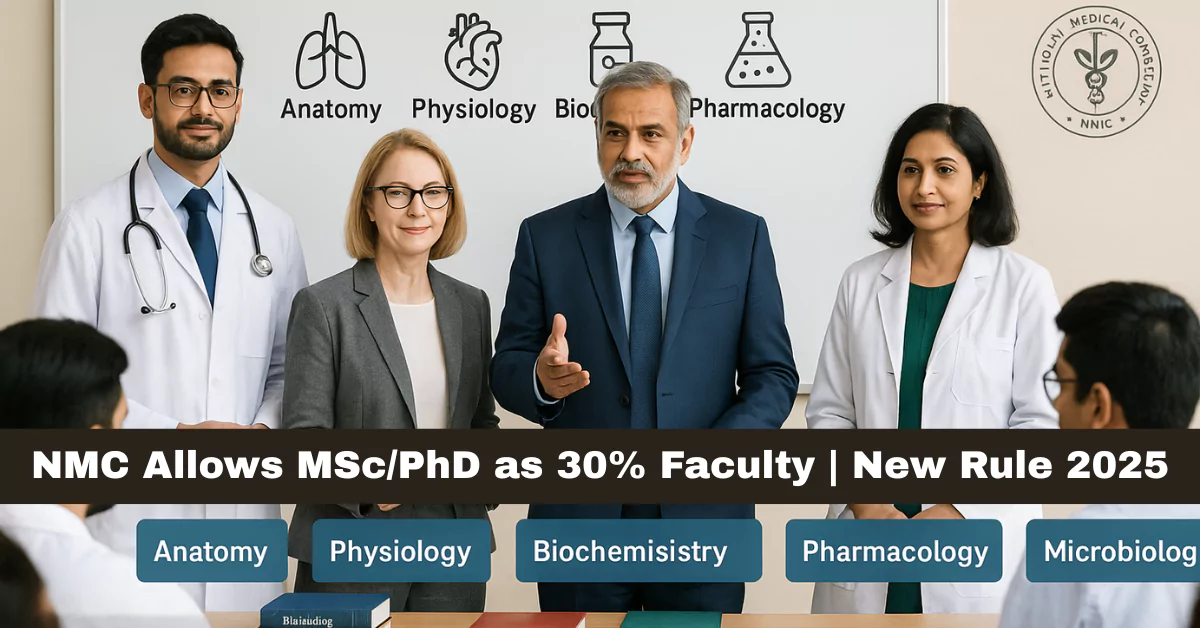The National Medical Commission (NMC) has notified that Medical MSc and PhD degree holders are allowed up to 30% of the faculty in five core non-clinical departments: Anatomy, Physiology, Biochemistry, Pharmacology, and Microbiology. It amends the previous regulations under the Minimum Qualifications for Teachers in Medical Institutions Regulations, 2022.
This marks a reversal of the controversial 2020 NMC rule that reduced the number of non-MBBS faculty permitted in medical colleges.
NMC Allows MSc/PhD as 30% of Faculty
Old vs New Rules: Summary
| Aspect | Old (2020–2024) | New (2025 Notification) |
| Eligible Subjects | 3 (Anatomy, Physiology, Biochem) | 5 (adds Microbiology, Pharmacology) |
| Non-MBBS Faculty Limit | 0–15% | Up to 30% |
| Eligibility | MBBS/MD only | MSc/PhD allowed if qualified |
| Transition Period Duration | Not applicable | Introduced but not defined |
NMC’s New Rule
- MSc/PhD degree holders in relevant disciplines can be appointed as faculty in up to 30% of positions in the five specified pre- and para-clinical subjects.
- This appointment is valid during a “transition period” when there is a documented shortage of medical faculty (MBBS/MD).
- Eligible candidates must have:
- A relevant MSc or PhD in the subject.
- A minimum of three years of teaching/research experience.
- At least two published research papers in indexed journals.
Why Was This Change Made?
India has been facing an acute shortage of qualified MBBS/MD faculty in non-clinical subjects. Many private and new medical colleges have struggled to fill vacant teaching positions, especially in tier-2 and tier-3 cities.
The National MSc Medical Teachers’ Association (NMMTA) has long advocated for the inclusion of non-MBBS educators, calling the earlier restrictions “unscientific and discriminatory.”
Its Impact On Medical Education
Positive Impact on Medical Education
Fills Teaching Gaps in Non-Clinical Subjects
Thousands of MBBS seats have been added in recent years, but the supply of MD-qualified faculty hasn’t kept pace. The 30% inclusion rule helps bridge this critical gap.
Boosts Academic and Research Culture
MSc/PhD professionals often possess a strong background in theoretical knowledge, research methodology, and laboratory techniques, which are essential for teaching subjects such as microbiology and pharmacology.
Job Creation for Non-MBBS Faculties
This reform creates thousands of teaching opportunities for MSc/PhD holders, many of whom were previously underutilised despite their domain expertise.
Global Best Practices
Several countries, including the UK, Canada, and Australia, employ non-MBBS PhD faculty in pre-clinical education. India’s new policy aligns with global standards.
Read Also: NMC Faculty Rules 2025: Aims to Expand Medical Education in India
Negative Impact & Concerns Raised
While the move has been praised by many, it has also triggered strong concerns among the medical fraternity, particularly clinical doctors and MBBS educators.
Dilution of Clinical Expertise
Critics argue that non-MBBS teachers may lack clinical understanding, which could compromise the integration of basic sciences with clinical medicine, a key focus of Competency-Based Medical Education (CBME).
Quality vs Quantity Debate
Allowing MSc/PhD faculty may solve staffing shortages, but it may also lower teaching quality if the recruitment criteria aren’t strictly enforced. There is worry that underqualified candidates could fill these slots in private colleges just to meet NMC norms.
Threat to Career Growth of MBBS/MD Educators
Many medical teachers believe this decision will reduce job opportunities for MD graduates, especially in teaching-focused specialties like anatomy and physiology, where jobs are already limited.
Lack of a Defined Transition Period
NMC has not clearly stated how long the “transition period” will last, leading to uncertainty among both medical and non-medical educators. This ambiguity may give private colleges leeway to exploit the clause indefinitely.
Unfair Promotion Pathways
Non-MBBS faculty are still not eligible to become Professors or HODs in most medical colleges. Despite being permitted to teach, they remain stuck in Associate Professor roles, creating frustration and limiting professional growth.
Way Forward
- NMC is expected to release detailed guidelines on the transition period and quality checks in faculty appointments.
- Medical colleges will now revise their faculty hiring plans to reflect the updated 30% eligibility clause.
- The demand for MSc/PhD education in medical sciences may increase, given the new teaching opportunities.
Read Also: AIIMS Faculty Shortage Crisis: Causes, Impact, and Solutions
The NMC’s decision to reintroduce non-MBBS MSc/PhD faculty in 5 departments is a double-edged sword. On one side, it solves an urgent faculty crisis and empowers deserving educators; on the other, it raises legitimate questions about teaching quality, clinical integration, and long-term academic policy clarity.
Implementation and regulation will be key. If executed with transparency, this can revitalise the backbone of Indian medical education, the non-clinical subjects that build foundational knowledge.

